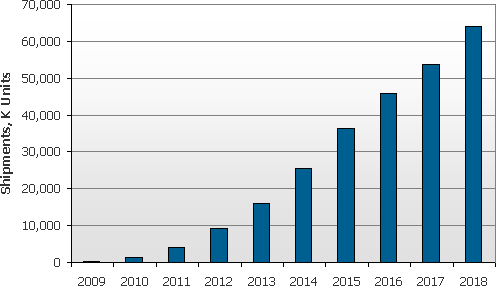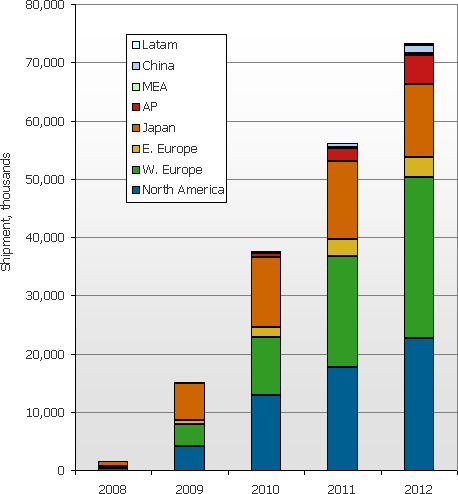3D-Capable TVs to Achieve 1.2M+ Shipments in 2010, 15.6M in 2013
Wednesday, January 20th, 2010
LED Backlighting and 240 Hz Serve as Enabling Technologies for New Feature Developments in TVs, Including 3D
AUSTIN, TEXAS — Closing out on a year in which average selling prices for TVs are expected to fall for the first time since the flat panel TV transition began, TV manufacturers are building new combinations to re-value their products and retain consumer interest.
In the newly launched Quarterly TV Design and Features Report, DisplaySearch research indicates that LED backlighting and 240 Hz LCDs will serve as enabling technologies for new feature developments in TVs in 2010, specifically for 3D TVs, an area of intense interest to TV manufacturers. DisplaySearch forecasts 3D-ready TVs will grow from 0.2 million units in 2009 to 64 million units in 2018.
“We have passed the first hurdle,” said Paul Gray, DisplaySearch Director of TV Electronics Research. “The critical Blu-ray 3D specification is written, but now comes the hard work of securing interoperability. Consumers will want reassurance that such things as 3D glasses will interoperate between brands. Retailers will also have the same demand to allow a thriving accessory market to develop. The next stage is less glamorous but vital to secure 3D’s long-term value. We have seen 3D crazes before, and sustained attention to detail is important to prevent disillusionment from starting.”
Figure 1: DisplaySearch 3D TV Set Forecast

Source: DisplaySearch Quarterly TV Design and Features Report
DisplaySearch forecasts that over 70 million connected TVs will be shipped in 2012–up from around 15 million in 2009.
Figure 2: DisplaySearch Connected TV Forecast

Source: DisplaySearch Quarterly TV Design and Features Report
“The Consumer Electronics Show (CES) demonstrated that Internet-connected TVs have finally come of age,” Gray added. “While in the past connected TV sets have seemed to be a solution in search of a problem, compelling new capabilities such as family video calling not only reinforce the TV’s central position in the home, but also represent a bold move to reclaim some of the tasks swallowed by the PC.”
DisplaySearch, the worldwide leader in display market research and consulting, has initiated a new research service, the Quarterly TV Design and Features Report, to analyze and forecast these trends.
The report is a quarterly update of the issues and fast-moving feature development in TV sets. The 200+ page report examines and forecasts video processor and signal processing IC market development including 120/100 and 200/240 Hz frame rates and market shares for major IC vendors; feature forecasting for MPEG-4 decoding and the digital broadcast environment around the world; TV connectivity, such as wired and wireless networked TVs; LED backlighting; 3D capability; remote controls and chassis design; audio; and power consumption.
In Q4’09 the report also analyzed the planned merger of NXP’s consumer activities with Trident. The Quarterly TV Design and Features Report is the only report to combine all these aspects of a fast-moving market and examine how they interact, and it is complete with a database of TV set featuring for over 200 models in low, mid and high positions in major regional markets.
Latest News
- Plex has largest FAST line-up with 1,112 channels
- TV3 migrates from on-prem servers to AWS Cloud with Redge
- Virgin Media partners with PubMatic to scale FAST advertising
- Interactive TV news channel unveiled by ROXi and Sinclair
- Spideo and OTTera unveil personalisation collaboration at NAB Show 2024
- Amagi integrates Intertrust DRM for FAST services